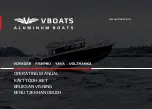
30
Operation
boat to ride the tide. The stern lines are crossed.
One line runs from the port aft boat cleat to the
starboard dock cleat and the other line runs from
the starboard aft boat cleat to the port cleat on
the dock. The stern lines center the boat, control
the forward motion and allow the boat to ride the
tide. Two forward quarter spring lines typically
are secured to the stern cleats and to mid ship
pilings or cleats. The spring lines keep the boat
from backing into the dock while allowing it to
ride the tide.
Leaving the Dock
Always start the engines and let them warm up
for several minutes before releasing the lines.
Boats steer from the stern and it is important that
you achieve enough clearance at the stern to ma-
neuver the boat as quickly as possible. Push the
stern off and maneuver such that you get stern
clearance quickly. Proceed slowly until well clear
of the dock and other boats.
Mooring
Approach the mooring heading into the wind or
current. Shift to neutral when you have just
enough headway to reach the buoy. Position a
crew member on the bow to retrieve the mooring
line with a boat hook and secure the line. Keep
the engines running until the line is secured.
Leaving a Mooring
Start the engines and let them warm up for sev-
eral minutes before releasing the mooring line.
The boat will already be headed into the wind,
so move it forward enough to loosen the line and
release it. Back the boat away from the mooring
until you can see the buoy. Move the boat slowly
away from the mooring.
Anchoring
Make sure the bitter end of the anchor line is
attached to boat before dropping the anchor.
Bring the bow into the wind or current and put
the engine in neutral. When the vessel comes to
a stop, lower the anchor over the bow. Pay out
anchor line so that it is at least 5 to 7 times the
depth of the water and secure the line to a cleat.
Use caution to avoid getting your feet or hands
tangled in the line. Additional scope of 10 times
the depth may be required for storm conditions.
Check landmarks on shore or your GPS position
to make sure the anchor is not dragging. If it
is dragging, you will have to start all over. It is
prudent to use two anchors at the bow if your are
anchoring overnight or in rough weather.
After the anchor is set, the windlass must not be
left to take the entire force from the anchor line.
Boats lying to their anchor in a high swell or heavy
weather conditions will snub on the line. This can
cause slippage or apply excessive loads to the
windlass. The line should always be made fast
to a bow cleat to relieve the load on the windlass.
Do not set a bow and stern anchor when moor-
ing, only anchor from the bow. The stern anchor
will not allow the boat to swing with the current
and wind. If your are anchored in a mooring with
other boats, your boat will not swing with the
other boats in the mooring, creating a potential
for contact with another boat when the tide or
wind changes. Additionally, having the stern to
the wind or tide creates a potentially hazardous
situation for the boat and crew.
Releasing the Anchor
Release the anchor by driving the boat slowly to
the point where the anchor line becomes verti-
cal. It should release when you pass that point.
If the anchor doesn’t release right away, stop the
boat directly above the anchor and tie the line to
the cleat as tight as possible. The up and down
movement of the boat will usually loosen the an-
chor within a minute. Make sure you secure the
anchor and properly stow the line before operat-
ing the boat.
WARNING
NEVER ANCHOR THE BOAT BY THE STERN. THE STERN
OF THE BOAT IS VULNERABLE TO SWAMPING FROM WAVE
ACTION AND WIND AND CURRENT WILL PUT MORE STRESS
ON THE ANCHOR WHEN IT IS ATTACHED TO THE STERN.
ONLY ANCHOR THE BOAT BY THE BOW
2.6 Controls, Steering or
Propulsion System Failure
If the propulsion, control or steering system fails
while you are operating the boat, bring the throttles
to idle and shift to neutral. Decide whether you
need to put out the anchor to prevent the boat
from drifting or to hold the bow into the seas. In-
vestigate and correct the problem if you can. Turn
the engine off before opening the engine cowling
to make repairs. If you are unable to correct the
problem, call for help.
If only one engine has failed, you can usually run
home on the other engine. Be careful not to apply
too much power to the engine that is running. When
Summary of Contents for 340 DC
Page 1: ...OWNER S MANUAL 340 DC...
Page 2: ...2 Revision 0 11 07 2018...
Page 14: ...14 NOTES...
Page 22: ...22 NOTES...
Page 25: ...25 Operation...
Page 86: ...86 NOTES...
Page 102: ...102 NOTES...
Page 122: ...122 NOTES...
Page 130: ...130 NOTES...
Page 149: ...149 MAINTENANCE LOG Appendix B Hours Date Dealer Service Repairs...
Page 150: ...150 Maintenance Log Hours Date Dealer Service Repairs...
Page 151: ...151 Maintenance Log Hours Date Dealer Service Repairs...
Page 152: ...152 Maintenance Log Hours Date Dealer Service Repairs...
Page 153: ...153 Maintenance Log Hours Date Dealer Service Repairs...
Page 154: ...154 Maintenance Log Hours Date Dealer Service Repairs...
Page 155: ...155 Appendix C BOATING ACCIDENT REPORT...
Page 156: ...156 Boating Accident Report...
Page 157: ...157 Boating Accident Report...
Page 158: ...158 NOTES...
Page 160: ...160 NOTES...
Page 167: ...CAUSE AND SOLUTION...
















































